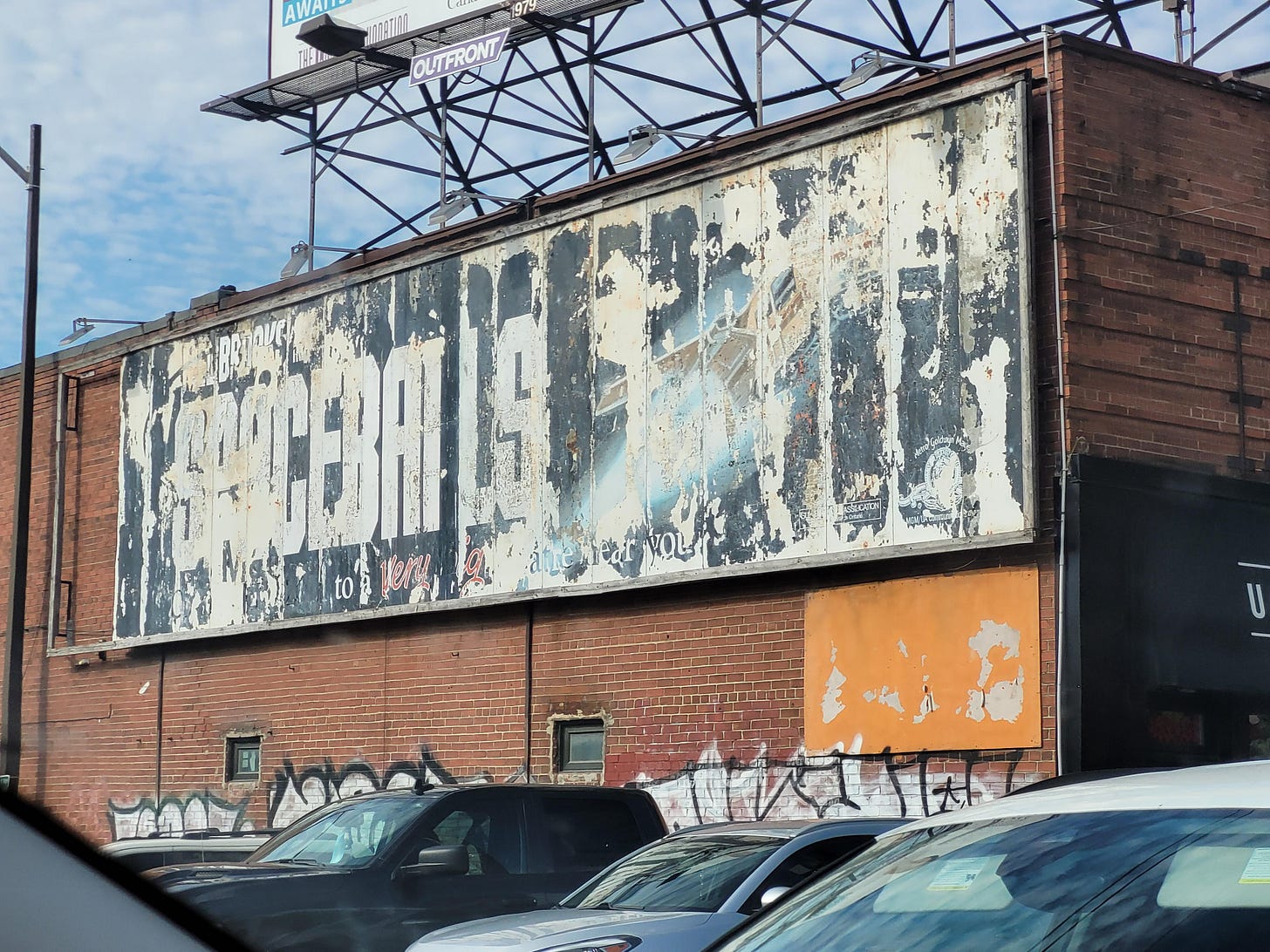Not everything has to be a screen: Why cities still need walls that remember
As painted billboards and walls give way to glowing screens, we’re erasing the unintentional archives that tell a city’s story, one ghost sign at a time.
Clinging to the side of a building in downtown Toronto, barely visible through layers of dirt and urban decay, is a billboard for Spaceballs. The ad has survived since 1987, tucked beneath newer signs, only resurfacing several years ago during construction. Its endurance isn't just funny — because, well, Spaceballs — it's oddly moving. A pop culture relic caught between nostalgia and erosion. And it's not alone.
Across North America, renovation projects continue to unearth old painted ads and forgotten murals. A century-old Gold Medal Flour advertisement was discovered during the restoration of a Minneapolis building. A circus poster in Wisconsin was found behind a bar, still vibrant beneath decades of plaster. These discoveries are never planned. They're accidents, but their emotional pull is powerful — a layered tapestry of time, commerce, and culture, sparking a sense of intrigue and wonder.
We don't always know they exist until we find them. But what happens when there's nothing left to find?
In Toronto's Annex neighborhood, a new mural on a residential laneway wall recently sparked online backlash. Some residents suspected it had been generated by AI, not because it looked strange, but because it seemed empty, devoid of authorship or meaning. The story was covered by Toronto Today, and while the mural's origins remain ambiguous, the concern it raised is apparent: in a city where visual storytelling is part of our shared environment, authenticity matters.
Cities have always been palimpsests. Rewritten over time, but never entirely erased. They're shaped not just by what's built, but by what's painted, posted, and pasted. Some of our most striking reminders of the past are uncovered, not preserved. Ghost signs and forgotten murals that surface during renovations like faded echoes. These aren't just relics of branding. They're proof of life. Past ambitions. Commercial nostalgia.
But that accidental archaeology is under threat. As physical signage gives way to digital screens and cloud-based content, the scraps of city memory, once preserved in pigment and plaster, are disappearing, leaving behind a growing void in our urban memory.
Today, more signage is dynamic and fleeting. Ads flicker across LED billboards. Messages appear for a moment in our feeds and vanish into the algorithm. We've traded pigment and permanence for pixels and programmatic inventory. The move to digital doesn't just change how cities communicate. It changes what cities remember and what they forget.
In the past, ghost signs were physical. Faded murals or weathered ads left behind on buildings became unintentional archives. They invited curiosity and speculation. But with digital billboards and cloud-based displays, there's often no record left behind. Nothing for future generations to stumble upon and interpret. Just blank screens ready for the next update.
This shift doesn't just affect memory, it affects meaning. When signage is disposable, the built environment stops offering layers. You get surface content, not sediment.
And while the ephemeral — the fleeting and impermanent — can be beautiful, it can also be hollow. That's why the AI mural example resonates: if a visual is created quickly to serve a moment, rather than reflecting its community or context, it's less likely to be remembered, or even noticed. Worse, if it sticks around, it might be misinterpreted as meaningful later on.
That's especially true with AI. It's not that AI or digital tools are inherently bad. But when they're used as shortcuts rather than expressions, they remove future context.
A ghost sign can tell you about typography trends, cultural priorities, or forgotten brands. A hastily generated AI mural might say nothing at all and still risk being mistaken for a genuine artifact of its era. It's not just a question of authenticity. It's about what kind of residue we leave behind.
We risk replacing ghost signs with ghost content, visuals that haunt space without ever truly occupying it.
That's why the resurgence of mural work in bars and restaurants is such a welcome reversal. As the Financial Times recently noted, bar murals are making a comeback, with venues commissioning local artists to create immersive, site-specific pieces. These aren't just decorative, they're memory anchors. They show that even in a world driven by screens, there's a hunger for art that lives in a place and speaks to it.
We're also seeing communities advocate for the preservation of old murals, such as the Lever Brothers soap factory mural in Toronto, which was at risk of destruction as the site was redeveloped. These efforts underscore a growing awareness that cities don't just need housing, transit, or technology. They need stories. Visual ones. Ones we can touch.
Maybe not everything should be designed for easy revision. Maybe not every surface needs to be a screen.
Cities are palimpsests, layered records of the people and ideas that shaped them. Let's not flatten those layers in the name of convenience. Because once memory becomes a subscription, the past becomes unreadable. And the future becomes forgettable.




